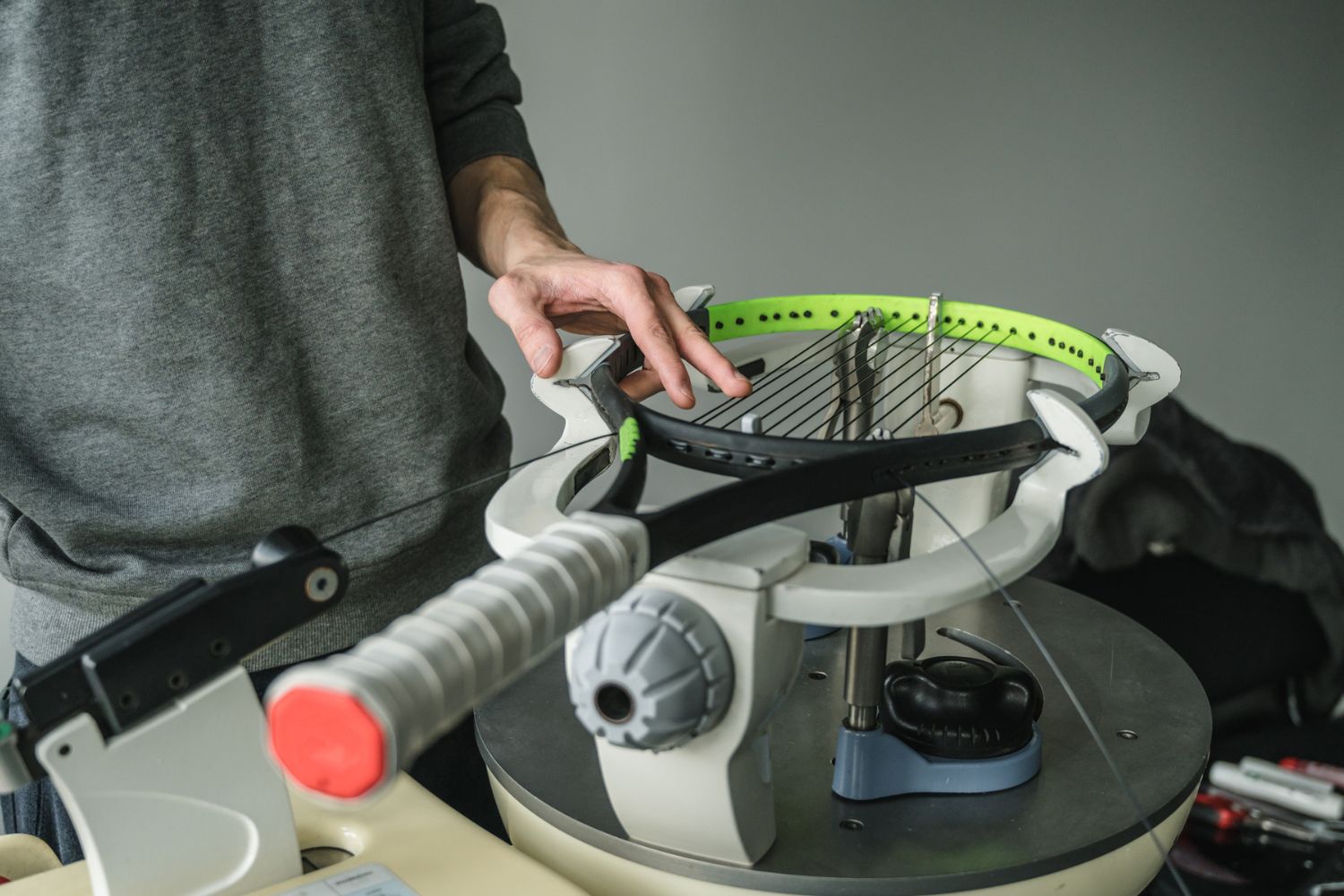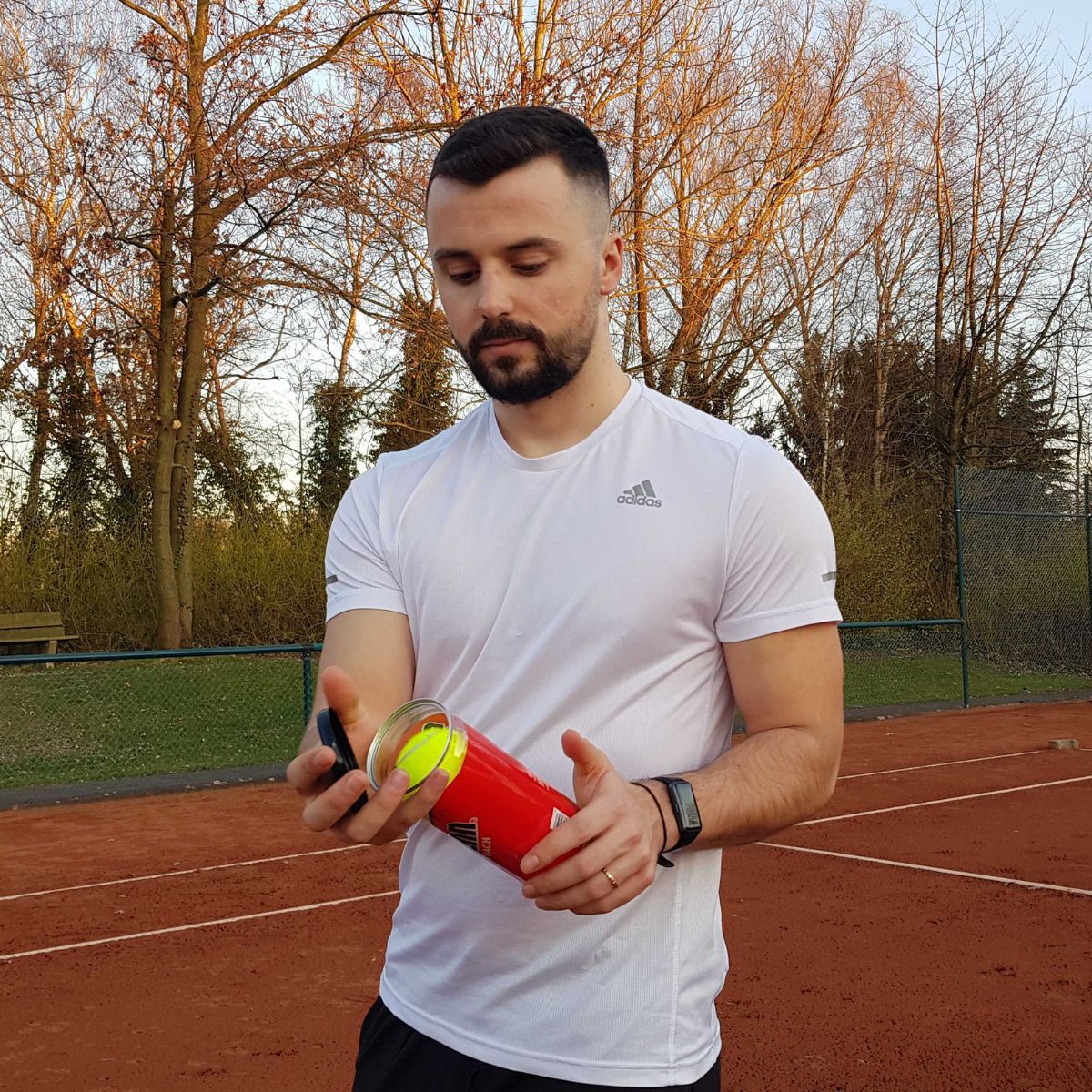- The average cost of restringing a tennis racket is $40.
- This price can range from $15-$75, based on the strings’ quality, brand, type and length.
- The process is not complicated and can be done by a professional or yourself.
- Players should restring their rackets as many times during the year as they play per week.
No matter if you are playing for fun or in a Wimbledon final, restringing your tennis racket is very important. With time and pressure, strings tend to lose tension, and as a result, the frame itself starts losing its main features, like power or control, compromising playability. Restringing the frame frequently will improve your experience on the court and help you keep up with your perfomance.
The average cost of the restringing process is about 40$, while this price can range anywhere from 15$ to 75$. These prices can differentiate based on the strings’ quality, brand, type, and length. The whole process is not complicated at all as soon as you get the hang of the main aspects of it. If you are also confused, keep scrolling!
- Typical Range: $15 – $75
- National Average: $40
Factors in Calculating Restring Tennis Racket Cost
The average cost of restringing a tennis racket is fairly low and easily affordable for the vast majority of the player. However, that does not mean you should rush the process with whatever is easily accessible at the moment, just for the sake of getting it over with. In fact, there are a few important factors to consider before, which will also play a part in the overall cost and sometimes hidden expenses.
Tennis String Brand Issue
A tennis racket restringing cost will be hugely affected by the brand you choose. Higher-end brands tend to charge more than the average, but they also guarantee quality and longevity. However, with a little effort, you can take advantage of the frequent discounts from big retailers or look for the most affordable string prices from reputable brands.
While the prices vary on the model, they can go as high as $75, or even $100, even though this is not a fixed cost.
If you are looking for cheaper versions, there are always string options from less-known brands that cost significantly less while still offering good quality. The average price on the lower end of the spectrums ranges from $10 to $15.
Tennis String Type
The price of a tennis string set is based on the type of material they are made of. This is probably your biggest decision, as the type of tennis strings will impact your performance and comfort levels on the court.
Natural gut is known for its many advantages and is preferred even by professional athletes; however, it is also the most expensive. Other options, like nylon or multifilament, might be a good replacement at more reasonable prices.
Kevlar and polyester are by far the least expensive ones, even though they also offer many advantages in the game. If you decide to go for a hybrid string type, then you have to spend more so that you can combine materials to mix and match features.
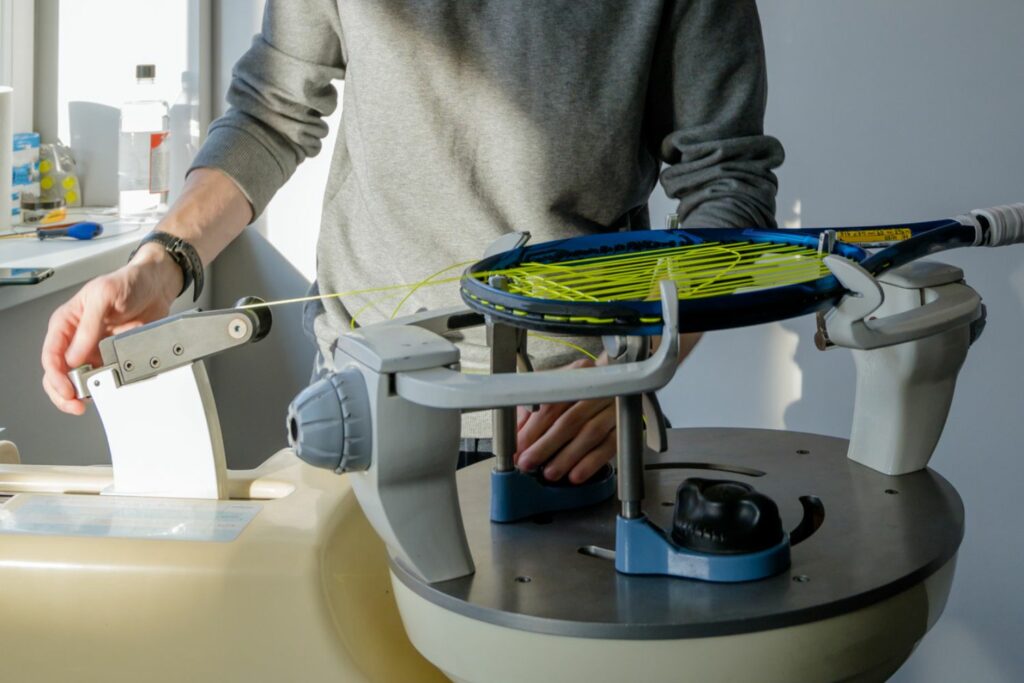
Labor
When taking your racket to a specialist to do the restraining process, it’s only normal to consider their fees and cost of labor first. If you are a beginner and have no idea where to start or where to go, it’s better to stick with those professionals that have to build a name for themselves in the area where you live.
The average fee for a professional restraining specialist might be $20. The price might be higher or less than that, depending on their experience, the local area, and expertise in the game. While you can also do the restringing process yourself, trusting a professional, it’s also a guarantee to pull the strings at the right tension rates.
Frequency
So how often do you need to restring the racket’s frames? The standard answer is when the string breaks, but in reality, a serious player replaces them sooner than that when the strings have already lost their tension and elasticity.
The golden rule is that a player should restring the frame as many times during the year, as many days of the week as it hits the courts.
For the majority of players, the restraining frequency is approximately 50 times per year. However, this is not a fixed rule because certain types of strings tend to break more often and are easier than other options. All of these factors obviously add to a player’s yearly budget for tennis racket restraining, considering the prices for material, brand, and labor costs.
Additional Costs and Considerations
In addition, the average cost to restring a tennis racket depends on a few other factors, which can increase the overall price. The restraining process often requires specific techniques and machinery and special customizations to fit better the players’ requests, which are often overlooked by most. Here are some of the hidden expenses that you should keep in mind, especially if you are on a tight budget.
Tennis Racket Grip
An ill-fitted racket grip is one of the worst experiences on the court. It will impact your perfomance, give you blisters, put unnecessary stress on the wrist, and even risk a possible injury. This is a much more common problem than you might think; that’s why it’s very common for players to adjust their tennis racket grip size.
Usually, you can do this on your own by adding an overgrip, which will cost you $10 to $20 and will fix the problem immediately. You can also do the opposite by reducing the handle size, but this can cost you up to hundreds of dollars and last quite some time. The smartest thing to do is to pick a smaller size grip than usual, so you can easily add some dimension to it if needed.
Customizations
Many players choose to customize their racket’s specifications in order to adjust features and performance. While there are many aspects to change, like weight, swingweight, balance, etc., the restringing process can also play a big role in a tennis racket’s customization.
Increasing or decreasing the tennis string gauge can directly impact a racket’s stiffness and comfort level, but also other features like power, spin, and control. Tennis string tension is also important for the racket’s performance and playability while also impacting crucial features like power, stability, control, and comfort.
To make certain adjustments, you should speak with your string specialist so that you can make the preferred changes. Usually, this process goes without extra charges, so you don’t have to worry about fees. However, it would be better to clarify this aspect beforehand, just in case.
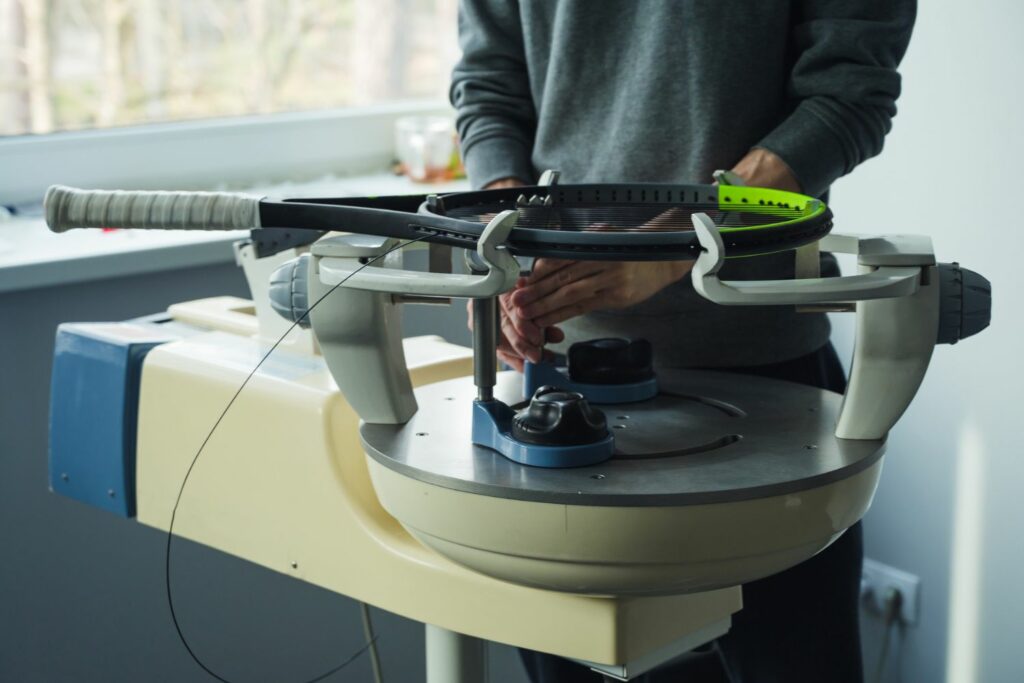
Tennis Restring Machine
If you restring the frame way too often, you can always make sure to check if the local tennis club has a restraining machine so that you can do the process by yourself. This specialized machinery can be a lifesaver and spare you so much time in the long run without the need to frequently see a specialist.
Usually, clubs can rent one of these, while buying a brand new one might cost from $200 up to thousands of dollars, depending on the size and brand. If you are serious about the game and want to splurge some money, a restringing machine can be a wise investment.
Types of Tennis Strings
When shopping and choosing tennis strings, the first thing you’ll notice is the big difference in cost between certain types of materials. That’s why it should not come as a surprise that the cost of restraining a tennis racket cost depends on the kind of string type you choose.
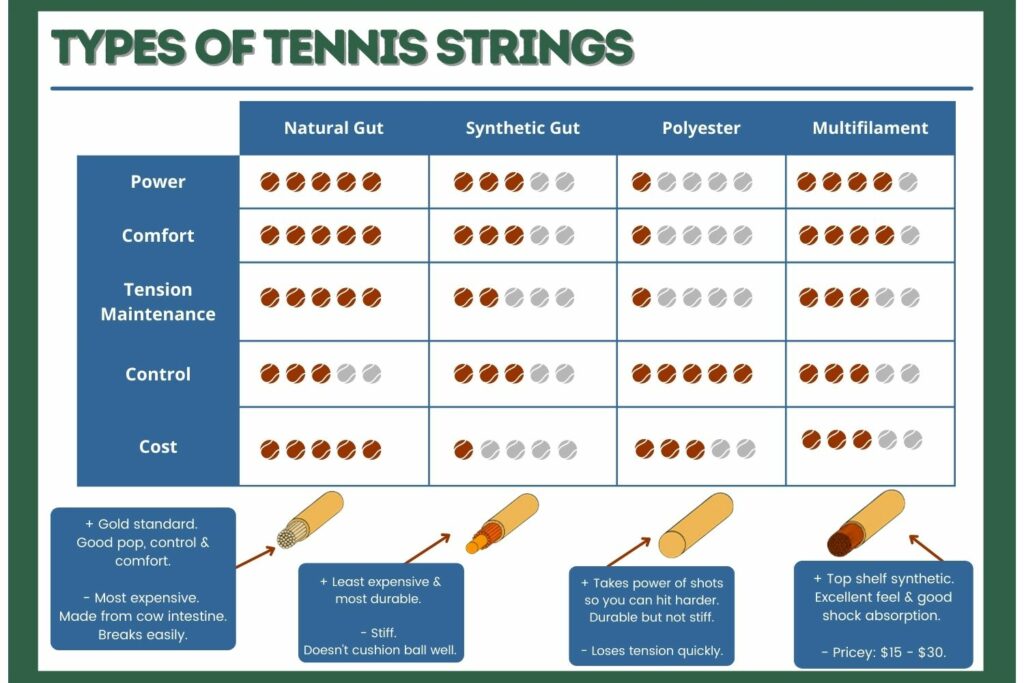
The price also correlates with performance and various features, which you should consider carefully.
Natural Gut
Natural guts are made of raw cows’ intestines materials. The process of creating a single pair of these strings requires hard labor and a strict, step-by-step process. While natural gut is one of the most popular choices among tennis players, it’s also the most expensive one. Their prices range up to hundreds of dollars, depending on the brands that sell them.
Natural gut is very soft and elastic, providing the player with a variety of different features. They are a safe choice for players that are suffering from complex injuries or tennis elbow conditions.
However, they do tend to break off more easily, especially for big hitters, meaning that you’ll have constant additional costs for the restringing process.
Multifilament
Multifilament tennis strings are made to mimic natural gut features, and we must say that the manufacturers have done a great job. However, the prices are significantly cheaper, making this type of string way more affordable for most players.
Replacing them is also more attainable; that’s why multifilament strings appeal even to beginners or recreational players who don’t want to break the bank on tennis equipment.
These types of strings offer a soft and plush feeling, making them comfortable to play with. They can generate easy power while also doing a good job of maintaining tension. The only downsides of multifilaments are the lack of control and spin potential, which is, for the most part, a fair trade.
Synthetic Gut
Synthetic gut strings are made mostly of nylon materials. They have a solid structure that is very durable and resistant to breakage or other damage. As a result, these types of strings will save you a lot of money, as they won’t need to be replaced as often. Also, they come in average or even cheap prices that are affordable by all.
Synthetic gut provides a variety of features, can hold tension well, and have a generous spin potential. While they are quite comfortable to play with, their performance is average; that’s why it appeals mostly to beginners or recreational players.
Polyester
Polyester has increased in popularity in recent years as the game has become progressively more competitive. This type of string is suitable mostly for advanced players looking to give an impeccable performance with heavy spin and high levels of control. They are extremely durable and resistant to breakage, which is a good thing for big hitters with an aggressive approach to the game.
Polyester strings come at reasonable prices, which makes them affordable for most players. However, they don’t hold tension well, which means polyester might need restraining more often than one would like.
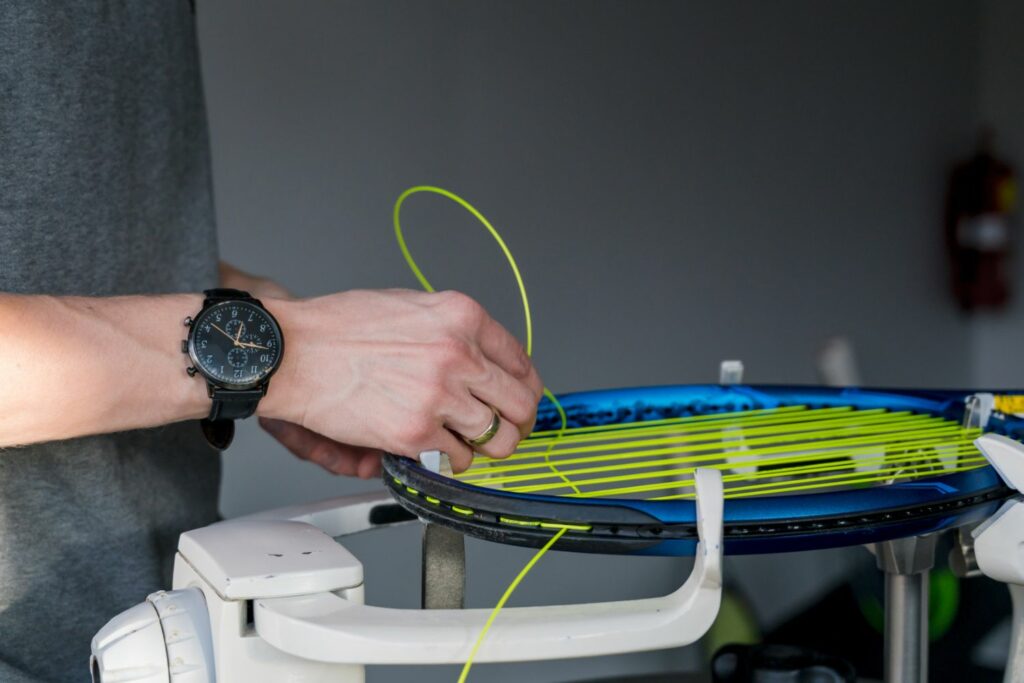
Restringing Tennis Racket Cost: DIY vs. Hiring a Professional
If you feel that you can restring the tennis racket all by yourself, it’s okay to try, at least. Many step-by-step tutorials all over the internet are easy to understand and follow, even for beginners. However, the restringing process might take you a lot of time, and you won’t be able to do the same job as a professional would. As a result, the frame strings might tend to break easily and tend to get loose as a result of tension dropping.
A tennis racket restringing cost is incredibly cheap, with an average cost of $20 dollars. Usually, the specialist also provides with necessary stringing machinery for a perfect job. Setting the tension and gauge rate is not as easy as it might seem, especially if you have never done it before. Meanwhile, machinery can spare you hours of hard labor by simply pushing the right buttons in a matter of minutes.
Where to Get a Tennis Racket Restrung
You might be wondering by now where to get a tennis racket restrung. Well, the simple answer would be the local club, where it can be easier to find the right machinery and experts to help you out with this process.

Big sports shops, preferably with a specialization in tennis equipment, are also a great option, as they often train their staff also to do the restraining of the racket. Freelance stringers are also an option, and you can look for one of them nearside your area. Most of the time, these people are trying to create an income for themselves and still have great, reasonable prices.
You can also restring the racket by yourself as a last resort, but make sure to follow instructions and even purchase specialized machinery.
Questions to Ask About Tennis Racket Restring Cost
Restringing your tennis racket’s frame is a common task among avid tennis players that want to keep their equipment in prime condition and maximize performance. While you might have gotten used to it by now, there are always some important questions to ask the stringer to obtain desirable results regarding the cost and the process of frame restringing.
- How long have you been in business?
- Are you a certified stringer?
- How long will the process last?
- Do you provide free estimates?
- What kind of equipment do you use for the stringing process?
- How much experience have you had in the stringing process?
- Would you recommend certain stringing adjustments that correlate to advancing my skills?
- Who will be completing the job?
FAQs
Tennis players should never ignore a string replacement. By regularly restringing the tennis racket, they can stay ahead of any potential (and likely expensive) issues. Restringing a tennis racket costs an average of $40, making it an affordable routine service.
Q: Is it worth restringing a tennis racket?
Yes, restringing a tennis racket is an effective way to prevent any damage and keep it in top condition. Regularly replacing the strings can help you maximize your performance on the court, as well as extend the life of your tennis racket.
Q: How long does it take to restring a tennis racket?
The length of time it takes to restring a tennis racket can vary depending on the complexity of the job, as well as the level of experience of the stringer. Typically, most jobs will take around an hour or less to complete.
Q: How do I know if my racket needs restringing?
There are a few tell-tale signs that your racket needs restringing. For example, if the frame feels loose or if the strings seem to be losing their tension, then it’s likely that your racket needs to be restrung.
Another sign that your racket needs restringing is if you’re noticing more consistent string breakages. If this is the case, it might be time for a new set of strings altogether. Additionally, if you’re finding that your shots aren’t as powerful or accurate as they once were, then it’s likely that your racket needs some attention.
Q: What happens if I don’t restring my tennis racket?
If you don’t restring your tennis racket, the tension in the strings will slowly decrease. As the tension decreases, the ball will start to bounce less, and the strings will start to wear out faster. Eventually, if the strings are completely worn out, they’ll break.
